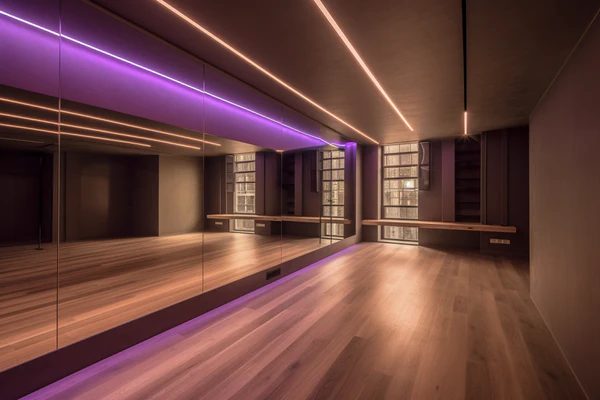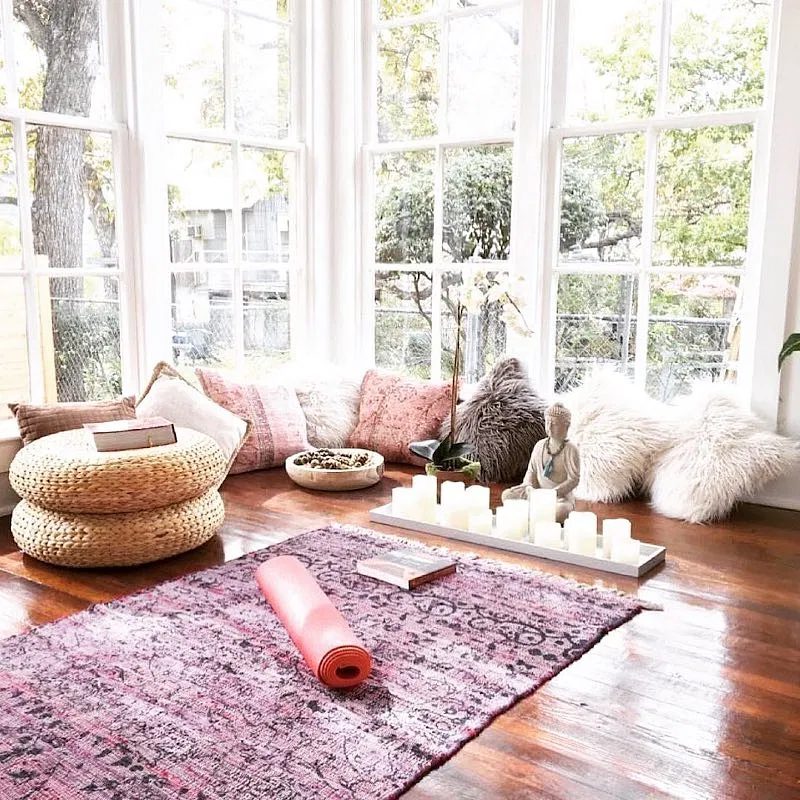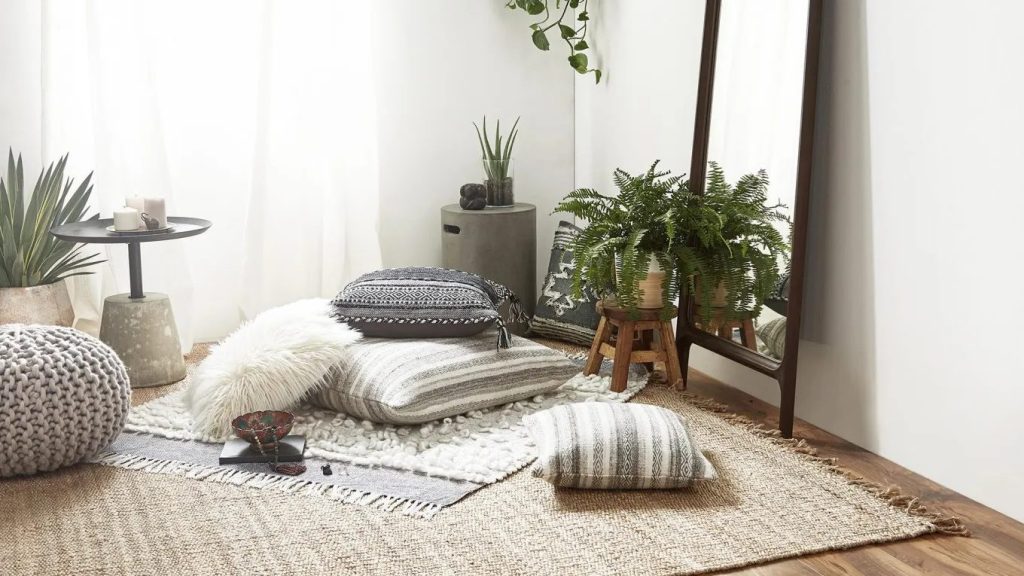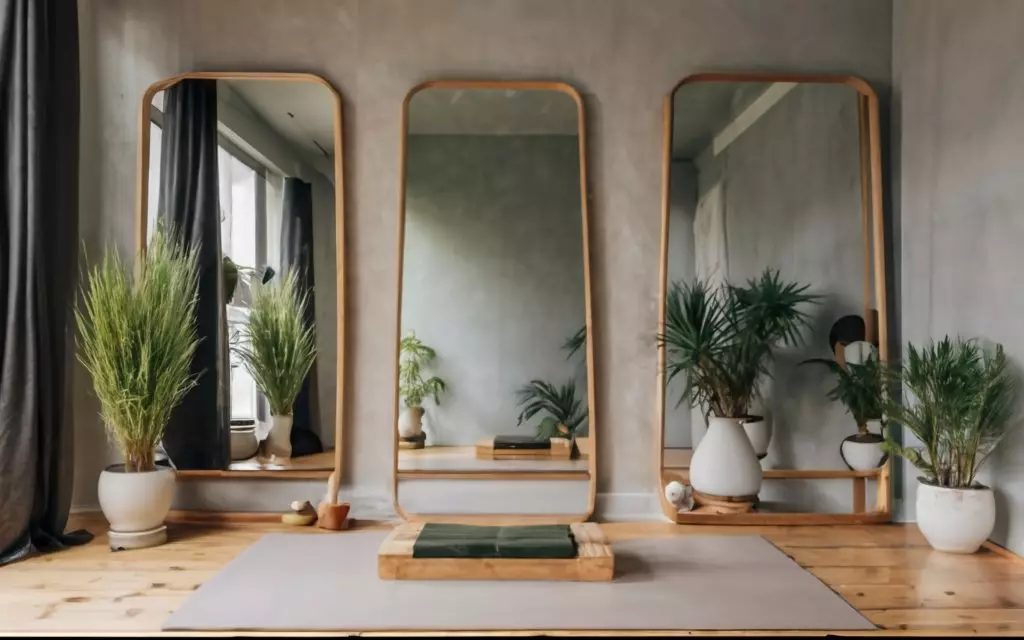In today’s fast-paced world, finding a sanctuary for self-care and inner peace is more crucial than ever. Enter the home yoga room – a personal oasis where you can stretch, breathe, and reconnect with yourself, free from the cacophony of daily life.
Whether you’re a seasoned yogi or a curious beginner, having a dedicated space for your practice can be truly transformative. It’s not just about physical exercise; it’s about creating an environment that nurtures your mind, body, and spirit.
This article will guide you through 30 inspiring ideas to help you craft your perfect yoga haven. From selecting the ideal location to incorporating elements that resonate with your unique style, we’ll explore ways to make your yoga room both functional and aesthetically pleasing.
So, roll out your mat and get ready to embark on a journey of creating a space that not only accommodates your asanas but also elevates your entire yoga experience.
Home Yoga Room Ideas
Let’s turn that spare corner or room into a sublime retreat that calls you to practice every day.
Setting the Foundation
1. Choose the Right Space

Selecting the ideal location for your home yoga room is crucial. Look for a quiet area in your home that offers privacy and minimal distractions. This could be a spare bedroom, a corner of your living room, or even a converted attic or basement space. The key is to find a spot where you can practice undisturbed and feel completely at ease.
Consider factors such as natural light, ventilation, and the overall ambiance of the space. A room with large windows can provide a connection to nature and flood your practice area with energizing sunlight. If possible, choose a space that’s separate from high-traffic areas of your home to maintain a sense of tranquility.
2. Clear the Clutter

A clutter-free environment is essential for a peaceful yoga practice. Start by removing any unnecessary furniture or items from your chosen space. This will not only create more room for movement but also help clear your mind of distractions. Embrace the minimalist approach and keep only the essentials in your yoga room.
Consider incorporating smart storage solutions to keep your yoga props and equipment organized. Wall-mounted shelves, baskets, or a dedicated storage cabinet can help maintain a tidy space while keeping your yoga accessories easily accessible. Remember, a clean and organized room will contribute to a more focused and enjoyable practice.
3. Choose Calming Colors

The color palette of your yoga room can significantly impact your mood and energy levels during practice. Opt for soothing, neutral tones that promote relaxation and focus. Soft blues, gentle greens, warm earth tones, and calming whites are all excellent choices for creating a serene atmosphere.
Consider painting an accent wall in a slightly deeper shade to add depth and interest to the space. You can also incorporate color through your choice of yoga mats, blankets, and other accessories. Remember to keep the overall palette harmonious and avoid overly bright or stimulating colors that might disrupt your concentration during practice.
Essential Elements
4. Invest in a Quality Yoga Mat

At the heart of any yoga practice is a good yoga mat. Invest in a high-quality, non-slip mat that provides adequate cushioning and support for your joints. Choose a mat that suits your preferred style of yoga and consider factors such as thickness, durability, and eco-friendliness.
Experiment with different materials and textures to find the mat that feels best for you. Some practitioners prefer natural rubber mats for their excellent grip, while others might opt for cork or specially designed microfiber mats. Don’t be afraid to try out a few options before settling on your perfect mat – it’s an essential tool that will accompany you through countless hours of practice.
5. Create a Sacred Space

Designate a special corner or area within your yoga room as a sacred space. This can serve as a focal point for meditation and reflection. Consider setting up a small altar or table where you can place meaningful objects, such as crystals, candles, or spiritual symbols that resonate with you.
This sacred space doesn’t have to be elaborate – even a simple shelf with a few carefully chosen items can create a sense of reverence and intention. Use this area to set your intentions before practice or as a place for quiet contemplation. Having a dedicated sacred space within your yoga room can help deepen your connection to your practice and create a more profound sense of purpose.
6. Incorporate Natural Elements

Bringing elements of nature into your yoga room can enhance its calming atmosphere and promote a sense of grounding. Consider adding potted plants or a small indoor garden to purify the air and introduce a touch of greenery. Succulents, peace lilies, or snake plants are low-maintenance options that thrive indoors and add a refreshing visual element to your space.
You can also incorporate natural materials such as wood, stone, or bamboo in your decor choices. A wooden floor or accent pieces can add warmth and texture, while a small indoor fountain or rock garden can introduce the soothing sounds and textures of nature. These natural elements will help create a harmonious environment that supports your yoga practice and overall well-being.
Lighting and Atmosphere
7. Harness Natural Light

Maximize the use of natural light in your yoga room to create an uplifting and energizing atmosphere. If possible, position your yoga mat near a window to take advantage of sunlight during your practice. Natural light not only brightens the space but also helps regulate your body’s circadian rhythms, potentially improving your mood and energy levels.
If privacy is a concern, consider using sheer curtains or frosted window film that allow light to filter through while maintaining a sense of seclusion. For early morning or evening practices, ensure you have adequate artificial lighting options to supplement or replace natural light as needed.
8. Install Dimmable Lighting

Flexible lighting options are essential for creating the right ambiance in your yoga room. Install dimmable lights or use smart bulbs that allow you to adjust the brightness and color temperature. This versatility enables you to tailor the lighting to different types of practices or times of day.
Consider incorporating a combination of overhead lights, wall sconces, and floor lamps to create layers of light that can be adjusted as needed. Soft, warm lighting is ideal for relaxing yin or restorative practices, while brighter, cooler light can be energizing for more vigorous vinyasa or power yoga sessions.
9. Add Ambient Lighting

Enhance the atmosphere of your yoga room with ambient lighting options. String lights, Himalayan salt lamps, or candles can add a warm, inviting glow to your space. These softer light sources create a cozy and intimate environment perfect for winding down after a long day or setting a meditative mood.
Be mindful of fire safety when using candles, and consider flameless LED alternatives for a similar effect without the risk. Experiment with different combinations of ambient lighting to find what works best for your practice and personal preferences. The right lighting can transform your yoga room into a truly magical space for self-discovery and inner peace.
Comfort and Support
10. Provide Proper Flooring

The right flooring can make a significant difference in your yoga practice. Ideally, choose a surface that provides some cushioning while remaining firm enough to support balance poses. Hardwood floors or bamboo are excellent options, offering a natural, warm feel and adequate stability.
If you’re working with an existing floor that’s less than ideal, consider laying interlocking foam tiles or a large area rug to create a more comfortable practice surface. These options can also help insulate against cold floors, making your yoga sessions more enjoyable year-round. Remember to ensure that any additional flooring is securely in place to prevent slipping during practice.
Related Guide: 30 Scandinavian Kitchen Ideas
11. Incorporate Supportive Props

Yoga props are invaluable tools for enhancing your practice, regardless of your skill level. Stock your yoga room with essential props such as blocks, straps, bolsters, and blankets. These accessories can help you achieve proper alignment, deepen stretches, and support you in challenging poses.
Consider creating a dedicated storage area for your props, keeping them easily accessible yet neatly organized. A simple shelving unit or a stylish woven basket can serve this purpose while adding to the room’s aesthetic. Having a variety of props on hand allows you to adapt your practice to your body’s needs on any given day, promoting safety and encouraging exploration in your yoga journey.
Personal Touches
12. Display Inspirational Artwork

Adorn the walls of your yoga room with artwork that inspires and uplifts you. Choose pieces that resonate with your personal yoga philosophy or that simply bring you joy. This could include nature photography, abstract paintings, or inspiring quotes beautifully rendered in calligraphy.
Consider creating a gallery wall with a mix of different-sized frames and art styles to add visual interest to your space. Alternatively, a large, statement piece can serve as a focal point during your practice, helping to center your thoughts and intentions. Remember to select artwork that complements the overall color scheme and atmosphere of your yoga room.
13. Incorporate Meaningful Symbols

Integrate symbols that hold personal significance or align with your spiritual beliefs into your yoga room decor. This could include mandalas, om symbols, Buddha statues, or any other iconography that resonates with you. These symbols can serve as powerful reminders of your practice’s deeper meaning and help create a sense of sacred space.
Be mindful not to overcrowd your space with too many symbols or decorative elements. Choose a few key pieces that truly speak to you and arrange them thoughtfully throughout the room. The goal is to create an environment that feels personally meaningful and conducive to introspection, without becoming visually overwhelming.
Sound and Silence
14. Create a Sound System

Music can be a powerful tool in enhancing your yoga practice, whether you prefer ambient sounds, instrumental melodies, or guided meditations. Set up a quality sound system in your yoga room to immerse yourself in soothing audio during your sessions. This could be as simple as a bluetooth speaker or as elaborate as a built-in surround sound system, depending on your preferences and budget.
Consider investing in a device that allows you to easily control your music without interrupting your flow. This could be a smart speaker with voice control or a wireless remote. Having a dedicated sound system in your yoga room allows you to curate playlists or guided practices that perfectly complement your mood and intentions for each session.
15. Embrace Silence

While music can enhance your practice, it’s equally important to create an environment that allows for moments of silence and stillness. Ensure your yoga room is well-insulated from outside noise to provide a quiet sanctuary for meditation and introspection. If external sounds are an issue, consider using a white noise machine or installing soundproofing materials to minimize distractions.
Designate certain practices or times for silent reflection, allowing yourself to tune into your breath and internal sensations without external audio stimuli. This balance between sound and silence in your yoga room can help you develop a more nuanced and mindful practice, attuning you to both external rhythms and your inner landscape.
Temperature Control
16. Install Proper Ventilation

Good air circulation is crucial for a comfortable yoga practice, especially during more vigorous sessions. Ensure your yoga room has adequate ventilation to keep the air fresh and prevent stuffiness. If possible, install a ceiling fan or use portable fans to promote air movement.
Consider adding an air purifier to your space, particularly if you live in an urban area or have allergies. This can help remove pollutants and allergens from the air, creating a cleaner, more breathable environment for your practice. Proper ventilation not only enhances your physical comfort but also supports the energetic flow of your practice.
17. Regulate Room Temperature

The ability to control the temperature in your yoga room can greatly enhance your practice experience. Install a thermostat or use a portable heater and air conditioner to maintain your ideal practice temperature. Some styles of yoga, like Bikram or hot yoga, require higher temperatures, while restorative practices might benefit from a cooler environment.
Consider adding insulation to your yoga room if it’s not already well-insulated. This can help maintain a consistent temperature and reduce energy costs. Additionally, use window treatments like thermal curtains or blinds to help regulate the room’s temperature by blocking out heat in summer and retaining warmth in winter.
Multi-functional Spaces
18. Create a Meditation Corner

Designate a specific area within your yoga room for meditation. This could be a cozy nook with floor cushions, a comfortable chair, or simply a designated spot on your yoga mat. Having a dedicated meditation space encourages regular practice and helps signal to your mind that it’s time to turn inward.
Enhance your meditation corner with elements that support your practice, such as a small table for holding incense or a singing bowl, a meditation cushion or bench for comfortable seating, and perhaps a soft blanket for warmth during longer sits. Keep this area simple and uncluttered to minimize distractions and create a serene atmosphere conducive to inner exploration.
19. Incorporate a Reading Nook

Expand the functionality of your yoga room by including a small reading nook. This can serve as a space for studying yoga philosophy, journaling about your practice, or simply relaxing with a good book. A comfortable chair or floor cushion, a small side table, and good lighting are all you need to create an inviting reading area.
Consider adding a bookshelf or floating shelves to house your yoga and wellness-related books, creating an easily accessible mini-library. This multi-functional approach allows you to spend more time in your yoga room, deepening your understanding of yoga beyond just the physical practice.
Storage Solutions
20. Utilize Vertical Space

Make the most of your yoga room’s dimensions by utilizing vertical space for storage. Install floating shelves or wall-mounted cabinets to store yoga props, books, and personal items without taking up valuable floor space. This approach keeps your practice area clear while ensuring all your essentials are within easy reach.
Consider using decorative ladder shelves or a pegboard system for a stylish and functional storage solution. These options allow you to easily adjust and rearrange your storage as your needs change. Vertical storage not only maximizes space but can also add visual interest to your yoga room, creating an organized and aesthetically pleasing environment.
21. Implement Hidden Storage

Incorporate hidden storage solutions to maintain a clutter-free, minimalist aesthetic in your yoga room. Look for furniture pieces that serve dual purposes, such as ottomans or benches with built-in storage compartments. These can be perfect for stowing away extra blankets, blocks, or personal items when not in use.
Another clever hidden storage idea is to use a room divider or folding screen with built-in shelves or hooks on the back. This allows you to create a separate, intimate space within a larger room while providing discreet storage options. By keeping your yoga accessories and personal items out of sight, you can maintain a sense of calm and spaciousness in your practice area.
Tech Integration
22. Set Up a Digital Display

Incorporate a digital display or smart TV into your yoga room to access online classes, tutorials, or inspiring visuals. Mount the screen on a wall where it’s easily visible from your mat, but ensure it can be hidden or turned off when not in use to maintain the room’s serene atmosphere.
Use your digital display to stream live yoga classes, follow along with recorded sessions, or display calming nature scenes during your practice. This tech integration can expand your yoga horizons, allowing you to experience different teaching styles and practices from the comfort of your home studio.
23. Create a Charging Station

Designate a small area in your yoga room for a charging station to keep your devices powered up and organized. This could be a sleek charging dock on a side table or a more discreet solution like a drawer with built-in charging capabilities. Having a dedicated spot for your phone, tablet, or other devices helps reduce the temptation to check them during practice while ensuring they’re ready for use when needed.
Consider using a charging station with multiple ports to accommodate various devices and perhaps those of family members or yoga buddies who might join you for practice. Keep the charging area neat and minimal, perhaps hiding cords with a cable management system to maintain the room’s peaceful aesthetic.
Personalization
24. Display Your Yoga Journey
Create a visual representation of your yoga journey by displaying meaningful mementos or achievements in your practice space. This could include framed photos from yoga retreats, certificates from teacher training programs, or even a vision board representing your yoga goals and aspirations.
Consider creating a “gratitude wall” where you can pin notes or small items that remind you of positive experiences or growth in your practice. This personal touch not only adds character to your yoga room but also serves as a source of motivation and reflection, connecting you to your broader yoga journey every time you step onto your mat.
Related Guide: 25 Home Fireplace Ideas
25. Incorporate Aromatherapy

Engage your sense of smell and enhance the ambiance of your yoga room with aromatherapy. Use an essential oil diffuser to disperse calming scents like lavender, eucalyptus, or sandalwood throughout your space. Different essential oils can be used to create various moods – invigorating scents for morning practices or soothing aromas for evening wind-downs.
Experiment with creating your own signature yoga room scent by blending different essential oils. You might also consider using natural incense or scented candles, being mindful of any sensitivities you or your practice partners might have. The right aromatherapy can transform your yoga room into a multi-sensory retreat, deepening your practice experience.
Eco-Friendly Options
26. Use Sustainable Materials

Make eco-conscious choices when designing your yoga room to align your space with the yogic principle of ahimsa (non-harm). Opt for sustainable materials in your flooring, furniture, and decor. This could include bamboo flooring, organic cotton yoga mats and props, or furniture made from reclaimed wood.
Look for non-toxic, low-VOC paints when coloring your walls, and choose energy-efficient lighting options like LED bulbs. By prioritizing sustainable materials, you create a healthier environment for your practice while also supporting broader environmental sustainability.
27. Incorporate Living Plants

Bring life and vitality to your yoga room by incorporating living plants. Not only do plants add a beautiful, natural aesthetic, but they also help purify the air and increase oxygen levels. Choose low-maintenance plants that thrive in indoor conditions, such as snake plants, pothos, or peace lilies.
Consider creating a small indoor garden or living wall as a focal point in your yoga room. This can serve as a natural piece of art and a reminder of your connection to the earth. Tending to your plants can become a mindful practice in itself, extending the benefits of your yoga practice into everyday life.
Flexibility and Adaptability
28. Design for Multiple Practices

Create a yoga room that can accommodate various styles of yoga and levels of practice. This might mean ensuring there’s enough open floor space for dynamic flows, as well as cozy corners for more restorative practices. Consider using modular furniture or easily movable pieces that allow you to reconfigure the space as needed.
Include props and equipment that support different types of yoga, from blocks and straps for alignment-focused practices to bolsters and blankets for restorative sessions. By designing a versatile space, you’ll be able to explore and grow in your practice without feeling limited by your environment.
29. Plan for Partner or Group Practice

Even if your yoga room is primarily for personal use, consider designing it to accommodate partner or small group practices occasionally. This might mean ensuring there’s enough floor space for two or more mats, or including some extra props and cushions for guests.
Creating a welcoming space for shared practice can enrich your yoga experience, allowing you to connect with friends or family members through yoga. It can also be useful if you ever decide to host small workshops or classes in your home studio.
Final Touches
30. Add a Personal Altar

Create a small personal altar in your yoga room as a focal point for setting intentions and expressing gratitude. This could be a simple shelf or a dedicated table where you can place meaningful objects, photos, or spiritual symbols that resonate with you.
Your altar might include items from nature, such as crystals or shells, religious or spiritual icons, or personal mementos that inspire you. Use this space to light a candle before your practice, set daily intentions, or simply as a visual reminder of what’s important to you in your yoga journey.
Conclusion
Creating a home yoga room is a beautiful way to deepen your practice and carve out a sacred space for self-care in your daily life. Whether you have an entire room to dedicate or just a corner of your living space, these 30 ideas can help you design a yoga sanctuary that reflects your personal style and supports your practice.
Remember, your yoga room should be a reflection of you – a space that feels welcoming, inspiring, and conducive to your growth. Don’t be afraid to experiment with different elements and adapt your space as your practice evolves. The most important aspect of any yoga room is the intention and energy you bring to it. With thoughtful design and a commitment to your practice, even the simplest space can become a powerful catalyst for transformation and inner peace.
As you implement these ideas, listen to your intuition and create a space that truly resonates with you. Your perfect yoga room is one that invites you to step onto your mat, breathe deeply, and connect with yourself day after day. May your home yoga room be a source of joy, growth, and serenity in your life.

